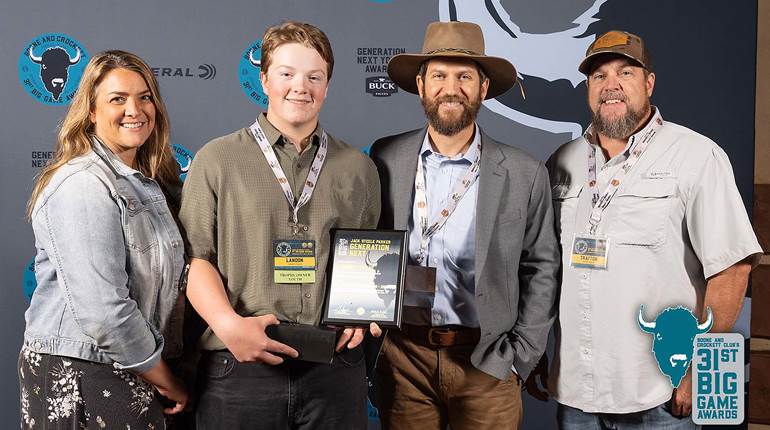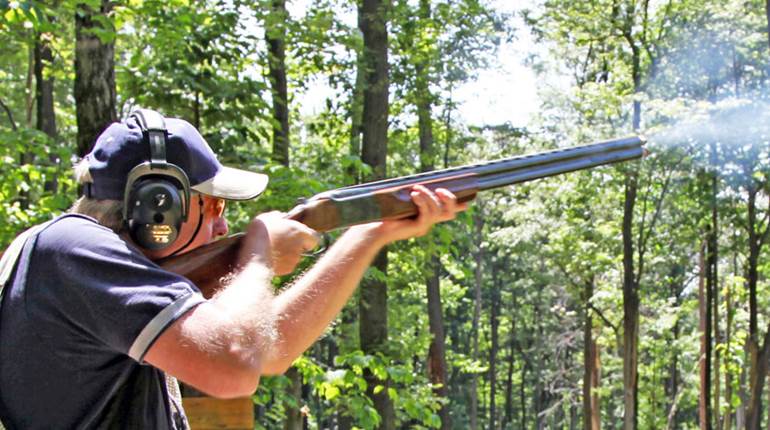
If things aren’t going well, first eliminate as many variables as possible. If the barrel is supposed to be free-floated, run a piece of paper from fore-end tip to action and make sure the stock isn’t bearing on it. Check the action screws and make sure they’re tight. Scope mounts are often the culprit, too.
American rifle shooters are a picky lot. We worship velocity and thirst for accuracy. Some of us, varmint hunters and those who pursue long-range shooting, actually have a need for both high velocity and extraordinary accuracy. Most of us, realistically, have more modest needs. We rarely shoot our deer beyond 200 yds., just like we always have—many of us, typically, at less than half that distance.
Whether our normal shooting distances are 100, 200 or even 300 yds. and beyond, even small deer have relatively large vital zones, and the bigger the animal, the larger the chest cavity. One could theorize that, at least for big game, “paper plate accuracy” at whatever maximum distance you’re comfortable shooting is plenty good enough. Of course, many serious rifle shooters are not hunters, but it doesn’t matter. Unless we’re talking extreme distance, paper plate accuracy doesn’t offer much in regards to bragging rights. We want more accuracy. Some of us go to extreme lengths trying to find it, others accept frustration and settle for less. Still others give up, pass the disappointing rifle on to someone else and start over. All three can be sound options, and I’ve exercised all of them, for sure.
Expectations And Measurements
If you take the first option, there are procedures you can try. The search for accuracy can be extensive, exhaustive and protracted, and you have to accept going in that you may never get there. All rifles are not created equal; some shoot better than others, and a few will never shoot well. To a degree, however, it depends on what you want.
Today, we have more accurate rifles, more consistent ammunition and better bullets than ever before. A generation ago, any sporting rifle that consistently produced minute-of-angle (m.o.a.) accuracy, usually expressed as 1" groups at 100 yds., was a rare gem. If you read the gun magazines today you might gather that most factory rifles will do this. Many will, more than ever before, but on a consistent basis this is still not the case. Half-minute accuracy also exists, and is more common than it used to be, but you aren’t likely to get it off a dealer’s shelf. I emphasize “factory” and “consistent” for a reason. Here’s why. Modern manufacturing has resulted in sound rifles being available at comparatively lower prices than ever before. Many of them produce astonishing accuracy, especially when you consider this: The primary source of potential accuracy is the barrel. If I wanted a super-accurate rifle I would start with the best-quality match-grade barrel I could find. Such a barrel will cost $500 or more. There are many entire production rifles that cost less than this. And yet some of the barrels on these lower-cost rifles will shoot almost as well as a top-quality barrel costing 10 times as much. Again, I stress “some” because, generally speaking, you get what you pay for.
Then there’s the matter of consistency. In the search for accuracy, it’s important to seek the average. Human nature being as it is, this can be challenging. The best three-shot group I’ve ever fired measured 0.052" from a Model 700 action re-barreled to 8 mm Rem. Mag. with a Pac-Nor barrel. That’s a “bragging rights” group I will never forget. It’s harder to remember that I could never again come close! Hey, that rifle is very accurate, easily sub-m.o.a.—but there is a vast gulf between 0.05" and 0.50".

So, how do you measure? This particular magazine has a tough protocol for published accuracy results: the average of five, five-shot groups. That’s a good measure, but it must be understood that rifles with slender barrels may not be capable of firing five shots without barrel heat causing the last couple of shots to “walk.” Fast cartridges and hot weather exacerbate this—as does bullet construction. You can establish your own testing criteria, and it’s okay to throw out groups with “called fliers”—bad shots that you know were your fault.
Look In The Mirror
Shooting for accuracy takes time and concentration. Some days will be better than others, and you must allow time for barrel cooling and frequent cleaning. In shooting for accuracy, the idea is to remove as much of the human element as possible, so be certain your benchrest technique is sound and the crosshairs are dead-steady when the trigger breaks.
It’s true that some cartridges tend to be more accurate—that rigidity of action is conducive to accuracy—and that match bullets are, on average, more accurate than hunting bullets. But the most important things in accuracy are good barrels mated concentrically to their actions, both bedded soundly into their stocks, and fed ammunition that the barrel likes. Beyond these things all other bets are off, and individual rifles will make lies of all other assumptions.

It is important to note that sights and triggers have nothing to do with accuracy. That said, magnifying sights and crisp, light triggers have much to do with allowing you to realize accuracy. A rifle with open sights and a creepy, heavy trigger may be a spectacular tack-driver, but you’ll probably never know it. Recoil can also be a limiting factor. Large-caliber cartridges are often extremely accurate, but it’s difficult to recognize this when you’re getting kicked into next week. So, if accuracy is a goal, think about a trigger job before you give up. For accuracy testing, think about mounting a scope with higher magnification. Finally, do whatever you need to do to attenuate recoil. The Lead Sled from Caldwell (btibrands.com) is a marvelous tool, and I regularly use a PAST Recoil Shield. Or just put a folded towel over your shoulder. Get comfortable, and you’ll shoot better.
Don’t Pre-Judge
There is no predicting how a given rifle will shoot. No doubt you have hopes and perhaps expectations. Maybe they’re realistic and maybe not, but there are no guarantees. Well, that’s not true. Some factory rifles today come with “m.o.a. guarantees.” They will probably make good with some loads, but it’s hard to know which loads—and these may not be the loads you prefer to use. Today, consistent m.o.a. accuracy is relatively common, although attaining it may take some experimentation. Half-minute accuracy is something else again. This is still uncommon, and half that again—quarter-m.o.a.—remains rare, especially on a consistent basis, no matter what you paid for the rifle.
Only you know how much accuracy you expect. Maybe you’ll get it, maybe you won’t, but a key piece of advice is to be patient. Barrel “break-in” is a real phenomenon. New barrels, especially factory barrels, have rough spots and tool marks. Some barrels shoot really well right out of the box, but most barrels will improve in accuracy after the passage of bullets has smoothed their interior surfaces. “Lapping,” whether with a mild abrasive compound on a cleaning rod or “fire-lapping” by firing bullets coated with mild abrasive, is simply smoothing a new barrel, and usually expedites the break-in process.
Every serious shooter has a personal protocol for “breaking in” a barrel. I recently spoke to a gentleman who breaks in barrels by firing one shot, cleaning, firing another shot, cleaning—clear up to 50 rounds. Few of us have such patience. When breaking in a new barrel I fire maybe three groups, then clean and repeat. Whether we’re talking one shot or a dozen, two things are important: First, do not let a new barrel get hot! Second, frequent cleaning (whatever that means to you) is essential.

South Carolina riflemaker Kenny Jarrett is one of the most revered names in rifle accuracy. A couple years ago I received a Jarrett .300 Win. Mag., supplied with a snazzy test target. I didn’t have Jarrett’s loads, and I couldn’t duplicate them. I started shooting groups, cleaning, shooting groups, etc. This particular rifle took about 60 rounds, and is now living up to its promise. Some barrels shoot well without break-in, and some take 100 rounds or more. My advice? Don’t give up too soon.
The Obvious Isn’t Always …
Recently I corresponded with a doctor from back east. In these pages I did a story on the new Kimber Hunter. Although not with all loads, my test rifle achieved that model’s “one-m.o.a. guarantee.” His would not, and in his initial letter there was a hint of “foul.” Hey, mine did, so I gave him my history with the brand and made some suggestions. His next letter took a different tone. Turns out his rear scope mount wasn’t secure and was moving. Of course he couldn’t get accuracy. That fixed, his Kimber Hunter was more accurate than the one I wrote about, down to 1/3" groups.
If things aren’t going well, first eliminate as many variables as possible. If the barrel is supposed to be free-floated, run a piece of paper from fore-end tip to action and make sure the stock isn’t bearing on it. Check the action screws and make sure they’re tight—but also make sure they aren’t too tight. A torque wrench can help ensure that tension is kept within proper specifications. Otherwise, applying too much torque risks drawing an action too tightly into the stock and creating a bind between it and the barrel.

As my new doctor friend re-learned, scope mounts are major culprits. So are scopes. A scope that is slightly loose internally can be hard to diagnose. Before swinging a frustrating rifle against a stout oak, think about switching to a scope from a rifle of known accuracy. I simply can’t tell you how many times I’ve been close to giving up when there was nothing wrong with the rifle, it was simply a bad scope.
Load Up!
No barrel shoots the same with all loads. Here is where your search for accuracy needs to be truly exhaustive. Some barrels are finicky, some are not, and that’s one reason the handloader has a huge advantage. Components can be varied endlessly—as can seating depths, neck sizing, sorting components and so many other tricks. Factory ammunition, though better than ever, is more limiting because any factory load is just one possible assembly of components. At a minimum, it is really essential to try several different brands and bullet weights and styles. “Match” ammunition is likely to be more accurate than “hunting” ammunition—but there are no guarantees—and also no predicting what load might enable a given rifle to produce its tightest groups.

I recall a .30-’06 Sprg.-chambered rifle that was just terrible with everything except the near-obsolete 220-gr. round-nose. Go figure. I had a Remington Mountain rifle in .280 Rem. that shot patterns—not groups—with all factory loads then available, but with handloaded 140-gr. Nosler AccuBonds it was instantly a tack driver. Be exhaustive in your search for the right loads. As with most things in accuracy, improvements are usually incremental and rarely exponential. But sometimes the difference in loads is dramatic. One more thing: Homogenous alloy bullets are very popular today and are required in “lead-free zones.” These are “hard bullets.” My experience is that some rifles shoot these bullets really well, better than lead-core bullets, and other rifles are just the reverse. So you may not always be able to use the bullets that shoot best in your rifle.
Shims and Crowns
As the search for accuracy becomes frustrating, we are inclined to implement radical solutions, such as changing the bedding. Sometimes this is warranted, and sometimes it works. But it’s also possible that you’re stuck with a bad barrel, and nothing will make it shoot. The search for loads the rifle likes best never really ends, but before hacking on the bedding—and certainly before giving up—there are a couple of little tricks you should try.
When accuracy is erratic—and especially if shots are stringing vertically—the first thing I try is shimming the barrel. Free-floating is the most common factory bedding because it’s the cheapest. It works well on many barrels, but it is actually the absence of bedding; the barrel is allowed to vibrate as it will. For many years, Winchester Model 70s and Remington Model 700s were commonly bedded with a bit of upward pressure on the barrel near the fore-end tip, which seems to make vibration more consistent. It is easy to replicate and easy to undo if it doesn’t work. Loosen the action screws enough so that you can slide a business card between the barrel and fore-end just behind the tip, and then retighten the action screws. Depending on the space between barrel and fore-end, it may take a couple of thicknesses, but the idea is to create a small amount of upward pressure on the barrel. It is amazing how often this produces instant improvement in accuracy.
You can increase the pressure with more cardboard, reduce it with less, and move the shim slightly forward and back to find the “sweet spot.” If it works you can replace the card with a thin piece of metal cut to fit, or simply soak the cardboard in oil so it won’t draw moisture and cause rust—but it leaves no marks and costs nothing, and often reaps accuracy dividends.

Another small trick is to check the crown. The crown is the last thing that touches the bullet, so it must be concentric. Factory crowns are often sloppy, and on used rifles crowns are often damaged, usually by the muzzle having been put down in a vehicle, where it grinds against grit. Checking the crown is another simple test that costs nothing. Paint the muzzle with typewriter correction fluid and fire a shot. The white paint will show blast marks adjacent to the rifling grooves, where gas escaped as the bullet exited. If the blast marks appear consistent all the way around the crown, it is probably fine, but if some blast marks are more prominent you may have a damaged or off-center crown, which is likely the cause of your accuracy woes. Re-cutting a crown is an inexpensive gunsmithing job, but if you have a lot of rifles you should probably check brownells.com and get a crown refacing kit.
A Silk Purse
As they say, you can’t turn a sow’s ear into a silk purse. No matter what you try, a given barrel can only shoot as well as it will. Gains in accuracy are rarely dramatic. So understand your goals, your actual needs and what you’ll settle for. A rifle that starts out shooting 2" groups is unlikely to become a sub-m.o.a. rifle. The rare rifle that starts out shooting m.o.a. groups may well become a half-m.o.a. rifle, but is unlikely to become the (much rarer) quarter-m.o.a. rifle. With some luck and a lot of work, it’s not impossible to cut your group sizes in half, but any more than that is unlikely. Reality is that, eventually, you must learn to live with what you have or invest in a better barrel and start over—or pass the rifle off and start over with something else. Sometimes, unfortunately, the only solution to accuracy is cutting your losses.
 The Accurate Rifle ... And Rifleman
The Accurate Rifle ... And Rifleman
Craig Boddington, a frequent contributor to these pages, has written a number of books on hunting and shooting, but his latest puts decades of experience at the range and in the field together in a useful, readable and well-illustrated package. The Accurate Rifle … And Rifleman covers just about every aspect of the rifle—including “Troubleshooting For Accuracy”—starting with the barrel, but also covers action types, iron sights, triggers, cartridges, bullets, optics and accessories. The chapters on shooting from the bench and from field positions, too, are demonstrative and well-reasoned. A guest chapter written by Phil Massaro, “Handloading for Accuracy,” is particularly informative. This is a gathering of hard-won knowledge from decades behind the buttplate. The 374-pp., 6"x9" hardcover book costs $35 plus $6.80 shipping, and signed copies are available from the author at craigboddington.com or by calling (406) 475-4994.
—Mark A. Keefe, IV, Editor In Chief






































